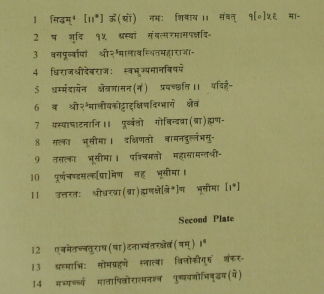|
The Indian Analyst
|
North Indian Inscriptions |
INSCRIPTIONS OF THE PARAMARAS OF BHINMAL ROPĪ PLATE INSCRIPTION OF DĒVARĀJA the inscription, the editor of the Epigraphia Indica remarks that the date is irregular for it is not verifiable either for Saṁvat 1059 or Saṁvat 1069. [1] ...The boundaries of the plot of land which was granted are mentioned in 11. 7-11 of the inscription. They are ; to the east, the land of the Brāhmaṇa Gōvinda ; to the south, the land of Vāmana, son of Durlabha ; to the west, the land of the village belonging to the mahā-sāmanta Pūrṇachaṇḍa; and to the north, the land of the Brāhmaṇa Śrīdhara. The witnesses were (i) Matvāka, the preceptor of Dēvarāja himself, and (ii) Pūrṇachaṇḍa (11. 19-20) who was evidently the same person mentioned above in 1. 10. The grant was written by Sūryaravi, a son of Nyāsa (11. 20-21). This account is followed by one of the customary hortatory verses, requesting the successors of the donor to continue the grant, and, with the sign-manual of Dēvarāja, the record comes to a close. ...As for the geographical names occurring in the inscription, Śrimāla, mentioned in 1. 3 is the modern Bhinmāl where the plates were found. The other place, Kshamamāthuna or Māthuna (1. 17), I am unable to identify, It may however be remarked here that there are two place both bearing the name Munthala, one of which is about 10 kms. south-east and the other about 18 kms. south-southeast of Bhinmāl, [2] and in view of the fact that this name sounds somewhat similar to Māthuna and also that the donated field is stated to have existed to the south of Bhinmāl and in the same direction as of either of these places, it is possible that either of these may have been intended here. If so, the village denoted by the first half of this name, viz., may have been Samrani, lying about 15 kms. south-west of Bhinmāl.
TEXT
[3]
[1]
See op. cit., p. 197 n. 2, I agree with the editor in his ramarks that from the Ind. Ephemeris we find that a lunar eclipse in Māgha occurred not in V. S. 1069 bu tin 1070, corresponding to 29th January,
1013 A.C. In V.S. 1059 there was no luner eclipse in the month, either for current or expired year.
|
||||||||||||||||||||||||||||||||||||||||||||||||||||||||||||||||||||||||||||||||||||
| > |
|
>
|








